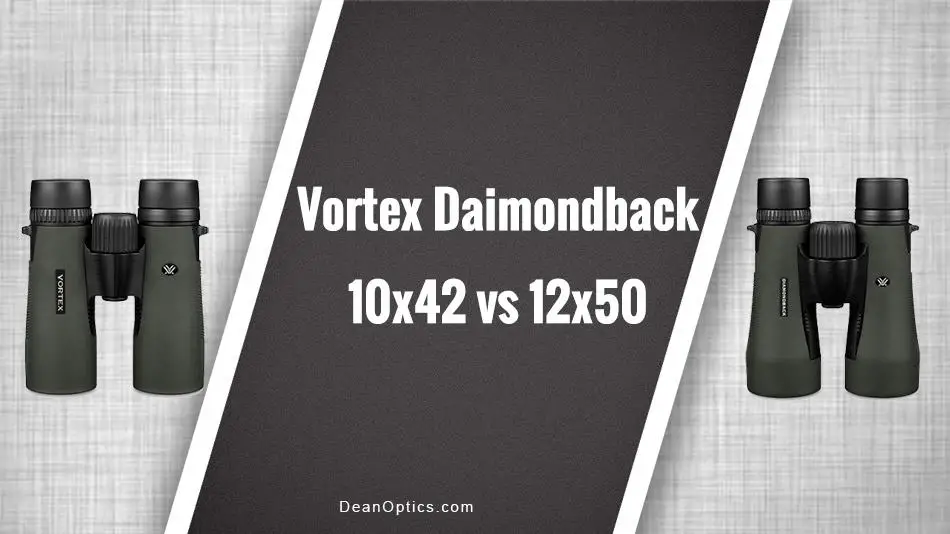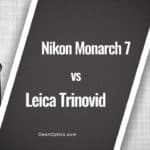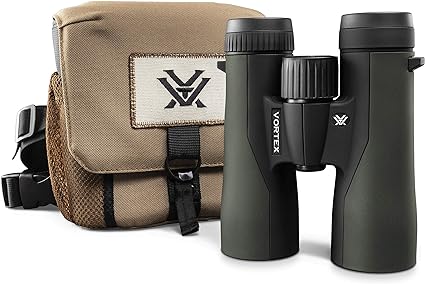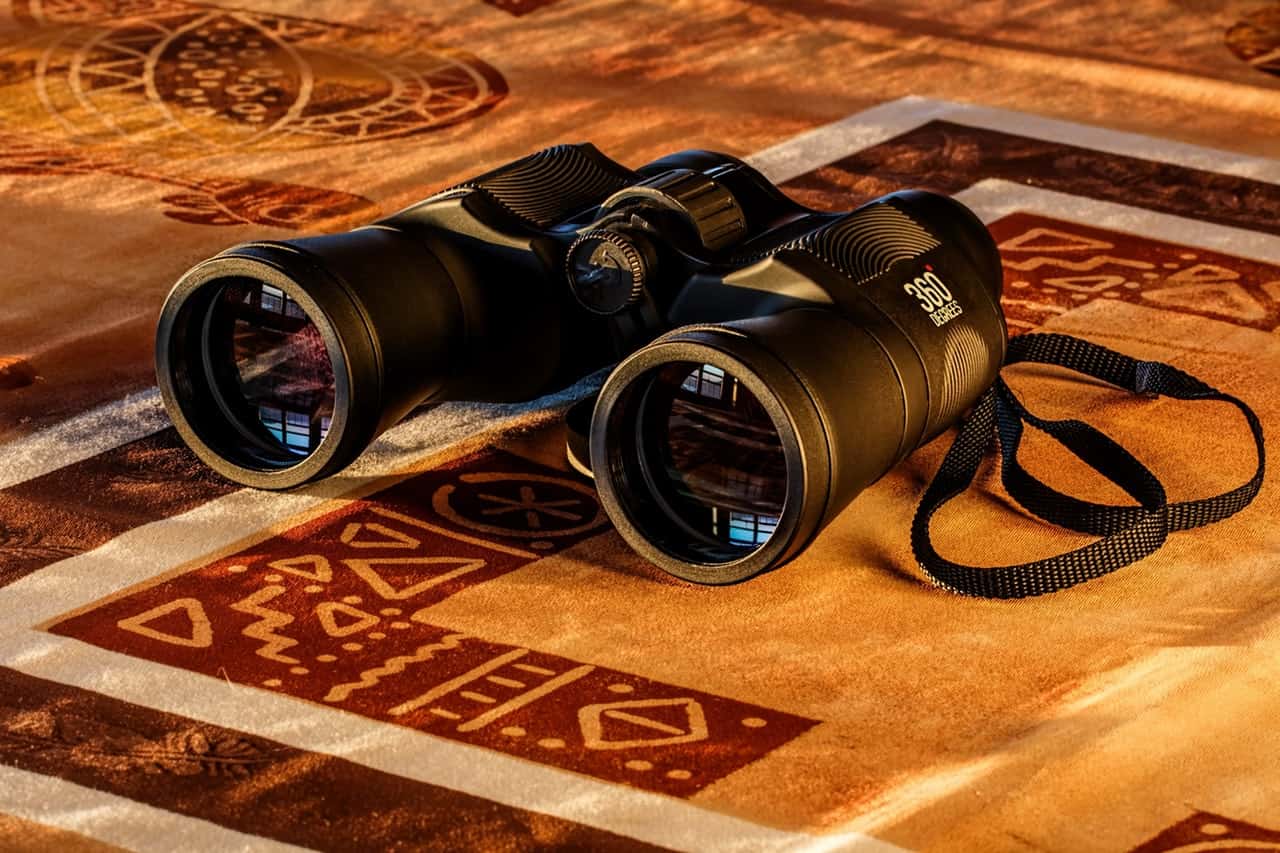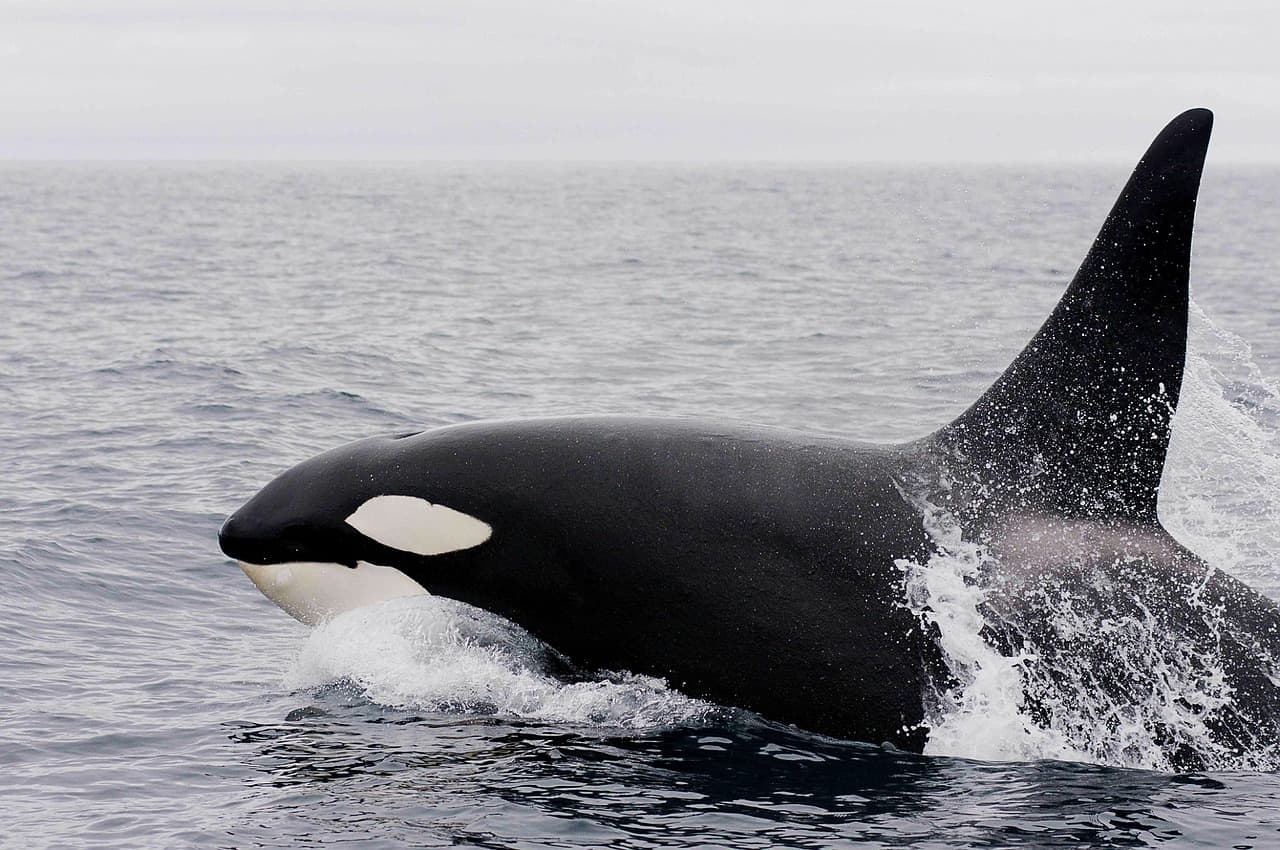Do you often get confused while shopping for binoculars? Does making a choice between two of your favourite brands make you anxious?
Do you want to know what will help you?
A side by side comparison of both binoculars. That’s right. We, at DeanOptics, strives to make binocular shopping easier for you.
Therefore, I am going to review and compare two of the most popular binoculars by Vortex Optics in this article.
“Vortex diamondbacks 10×42 VS 12×50 binoculars.”
Stick with me here to understand which binocular is more suitable for you and why?



Vortex Diamondback 10×42 vs 12×50 – Pros and Cons
Here is a trick to make the best buying decision (one that you won’t regret) – a decisive list of pros and cons of each product.
Listed down below is a precise comparison of Vortex diamondback 10×42 VS 12×50 in terms of Pros and Cons.
Vortex 10×42 binocular pros
- Roof prism for more compact design
- Fully multi-coated lenses for better performance in low lights
- Extended field of view
- Comes with good quality carry case
- Lifetime warranty (no questions asked)
- Reasonably priced
Vortex 10×42 binocular cons
- Lens caps are not attached so they can get lost.
- Minimal amount of Chromatic aberrations.
Vortex Diamondback 12×50 pros
- Ultra-wide field of view
- Fully multi-coated lenses generate stunning pictures even in low light surroundings.
- Sleek and ergonomic design
- Adjustable and extended eye-relief for eyeglass wearers
- VIP lifetime warranty
- Compact and light-weight
Vortex Diamondback 12×50 cons
- A bit expensive compared to 10×42 binoculars.
- Not suitable for people with small faces. The distance between ocular lenses can hinder the view.
Vortex Diamondback 10×42 vs 12×50 – comparison based on activities
Your high-end and expensive binoculars will go to waste if they are not suitable for your desired activities.
Read on to find out which binocular magnification by Vortex is ideal for you.
1. Hunting
In the United States, hunting is a great business. According to NSSF, the hunting industry provides 680,000 jobs in America.
From the fact above, it is quite evident that hunting is an important activity; whether you hunt for enjoyment or to earn.
To a hunter, a binocular is like a third eye. And you are going to need a third eye in hunting all right.
From magnification to ergonomics to crystal clear pictures- Vortex diamondbacks are ideal for hunting.
But for hunting, you need a compact design and something lightweight. 10×42 diamondbacks are fairly light compared to 12×50 diamondbacks.
Winner: Vortex Diamondback 10×42
2. Stargazing
Ordinary binoculars lets you see up to 50x more stars compared to a naked eye. Celestial bodies like Stars, Planets, Moon, Space stations, Milky ways, our neighbour Jupiter, galaxies, etc. are just a pair of optics away from you to explore.
No wonder, stargazing is quite an addictive hobby. You might think you need the highest magnification to see celestial bodies that are Millions of years away, but hey, you are wrong here.
Aperture or objective lens diameter is an important factor for stargazing binoculars because to explore far off celestial bodies that are dim in the night sky, you need binocular that gather light.
Vortex Diamondback 12×50 binoculars will let you spot dim objects more easily. You can put them on a tripod to reduce the image shakiness.
Winner: Vortex Diamondback 12×50 binocular.
3. Bird watching/Birding
Bird watching is a favourite past time in America. Did you know, about 50 million Americans go on an outing for bird watching every year?
Apart from being convenient and inexpensive, bird watching is a great way to connect with nature. Of course, you can’t watch birds without a good pair of optics. That is like fishing without a hook.
A good binocular for Bird watching is compulsory. Luckily, both 10×42 and 12×50 binoculars by Vortex optics are well-suited for birding.
While 10×42 diamondback has a larger field of view as compared to 12×50, the magnification power of 12×50 somehow levels the playing field.
Serious birders and wildlife experts love to see every tiny detail of rare and exotic birds to determine their breed and other features. Clearly, 12×50 binoculars by Vortex is a winner in magnification.
But if you want a wider field of view and just enjoy birding for recreation purposes and to relax, 10×42 diamondback is a good choice.
Winner: Tie
Also, read my comparison of Nikon Monarch 7 vs Vortex Viper HD.
Vortex Diamondback 10×42 VS 12×50 – comparison based on features
1. Magnification and Aperture
For long-distance terrestrial viewing where you need to see details, higher magnification is preferable.
Binos with larger aperture lets in more light hence making the far off objects brighter and visible.
So if you need a high powered binocular, diamondback 12×50 is a sane choice.
Winner: 12×50 Diamondback Binocular
2. Field of view
Field of view is an area that you can see when you put a binocular to the eye. For the field of view, we can easily say, the more the merrier.
With an Extended field of view, you can see and explore more. Vortex diamondback 10×42 has FOV of 330 ft. while 12×50 diamondback features 271 ft.@1000 yards.
Winner: Vortex Diamondback 10×42 Binocular
3. Stabilized image
One drawback of higher magnification is the compromise in image stability. Every tremor, move, and bump gets enhanced too. This eventually leads towards a downfall in image quality.
Evidently, 10×42 will provides more stabilized image compared to 12×50 binoculars. However, this issue is not very prominent because of the high-quality lens coatings and prism Glass.
And with 12×50 binocular, you always have an option to use a tripod to make the view smoother. Go any higher than 12x and you are sure to see some distortion in images.
Winner: Tie
4. Lens coating
Both Vortex diamondback 10×42 and 12×50 have fully multi-coated lenses that significantly improve the picture quality. Fully multi-coated lenses warrant a picture that is brighter, sharper and clearer than binoculars with only multi-coated lenses.
Winner: Tie
5. Close Focus
Binoculars with good close focus let you see nearby things with vivid details. Birders can especially relate to this as they use close focus quite often to spy on hidden birds that are nearby but you don’t want to startle them by getting too close.
Here, 12×50 have a slight edge over 10×42 binoculars. 12×50 diamondback have 7 ft. close focus distance while 10×42 have 6.7 ft. close focus.
Winner: 12×50 diamondback Binocular
6. Weight ergonomics
It goes without saying, the bigger the lenses, bulkier the binocular. Weight is an important factor for many people especially if you want to travel around with your binocular.
No one fancy carrying a bulky binocular on a long trek or an extended hunting trip. 10×42 is understandably more lightweight and compact then 12×50 diamondbacks.
12×50 weighs 28.07 0z while 10×42 weighs 21.4 oz. 10×42 is quite lightweight if weight is the main point of concern for you.
Winner: Vortex 10×42 diamondback.
Vortex Diamondback 10×42 vs 12×50 – comparison based on cost and value
In the end, it all boils down to this: the price tag. No matter how fancy and high-tech the binoculars are, they are useless if they are out of your range.
So always invest wisely. Stretch your budget as much as possible but do not go overboard.
Let’s see which one of these beauty provides more value for money?
Understandably, 10×42 have reasonable price tag compared to 12×50 diamondback. 12×50 have higher magnification and bigger lenses to make up for extra bucks.
If you are a beginner and want versatile binoculars to meet all your needs, Vortex diamondback 10×42 is highly recommended.
Go for Vortex 12×50 diamondback if you are someone who takes glassing seriously. And if you want a high powered binocular to take care of all your outdoor shenanigans.
Great, now which one should I pick?
This comparison ends HERE and ladies and gentlemen as you can see it’s a “TIE”. Well don’t worry, you can still easily make your decision:
If you want an affordable binocular with all the must-have features, and high optical performance- go with Vortex Diamondback 10×42.
If you are inclined towards spending more money and want a pair of optics that produce stunning images with maximum brightness and higher magnification – Vortex 12×50 diamondback is waiting for you.
Either way, you cannot go wrong with Vortex, what with that VIP lifetime warranty that lets you exchange or replace your binocular without any receipts or questions.
Two thumbs up for Vortex!
Shop wisely and keep exploring…Glassers!
Image credits (binoculars): Vortex Optics

An optics enthusiast – I love bird watching as well as wildlife. Originally from South Africa, I moved to the UK at a young age. I love reviewing the latest binoculars as well as traveling. I work as a comms consultant during the day. My plan is to travel across the world so building up to that goal.
Last update on 2025-01-20 at 23:11 / Affiliate links / Images from Amazon Product Advertising API

